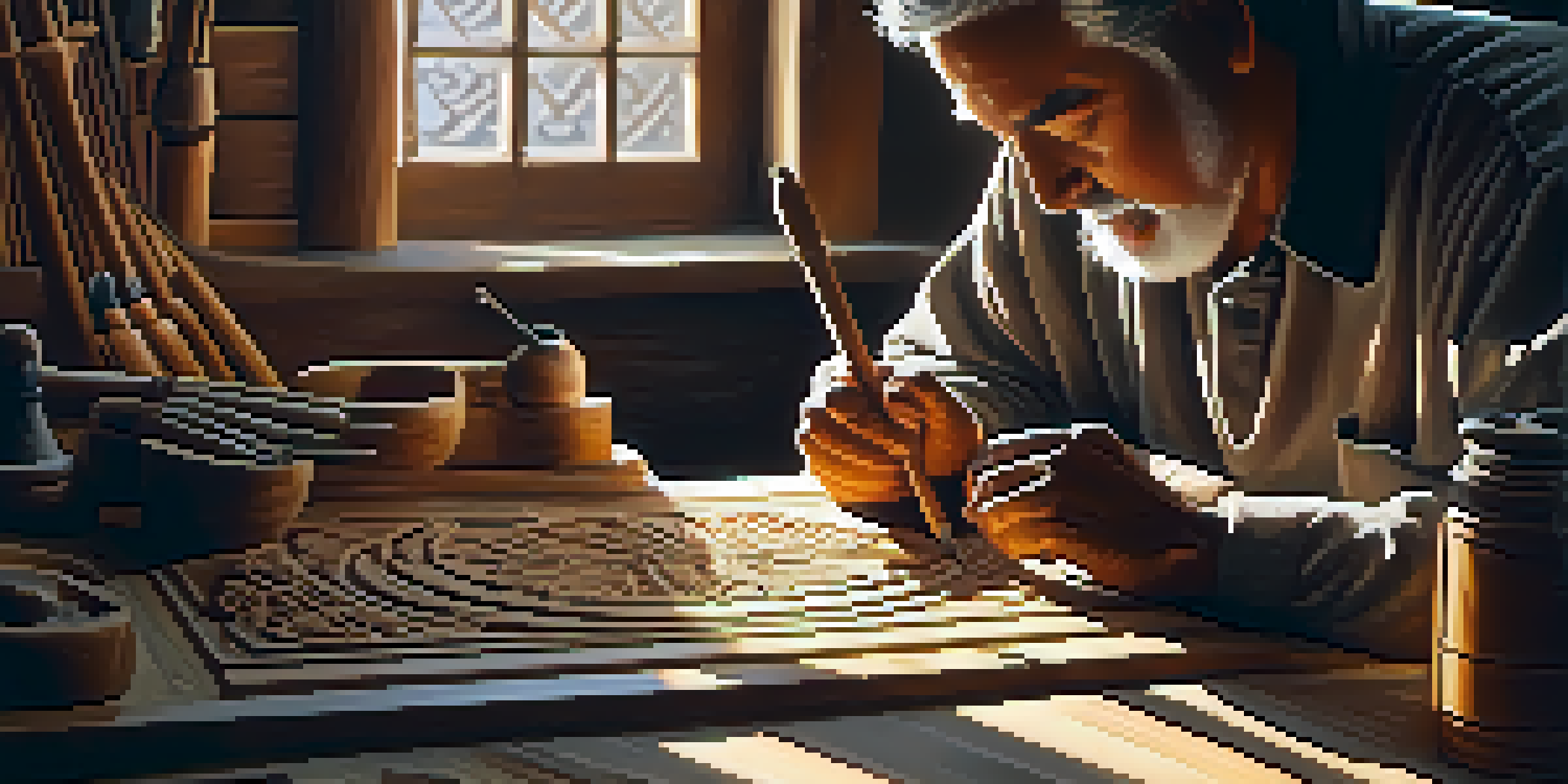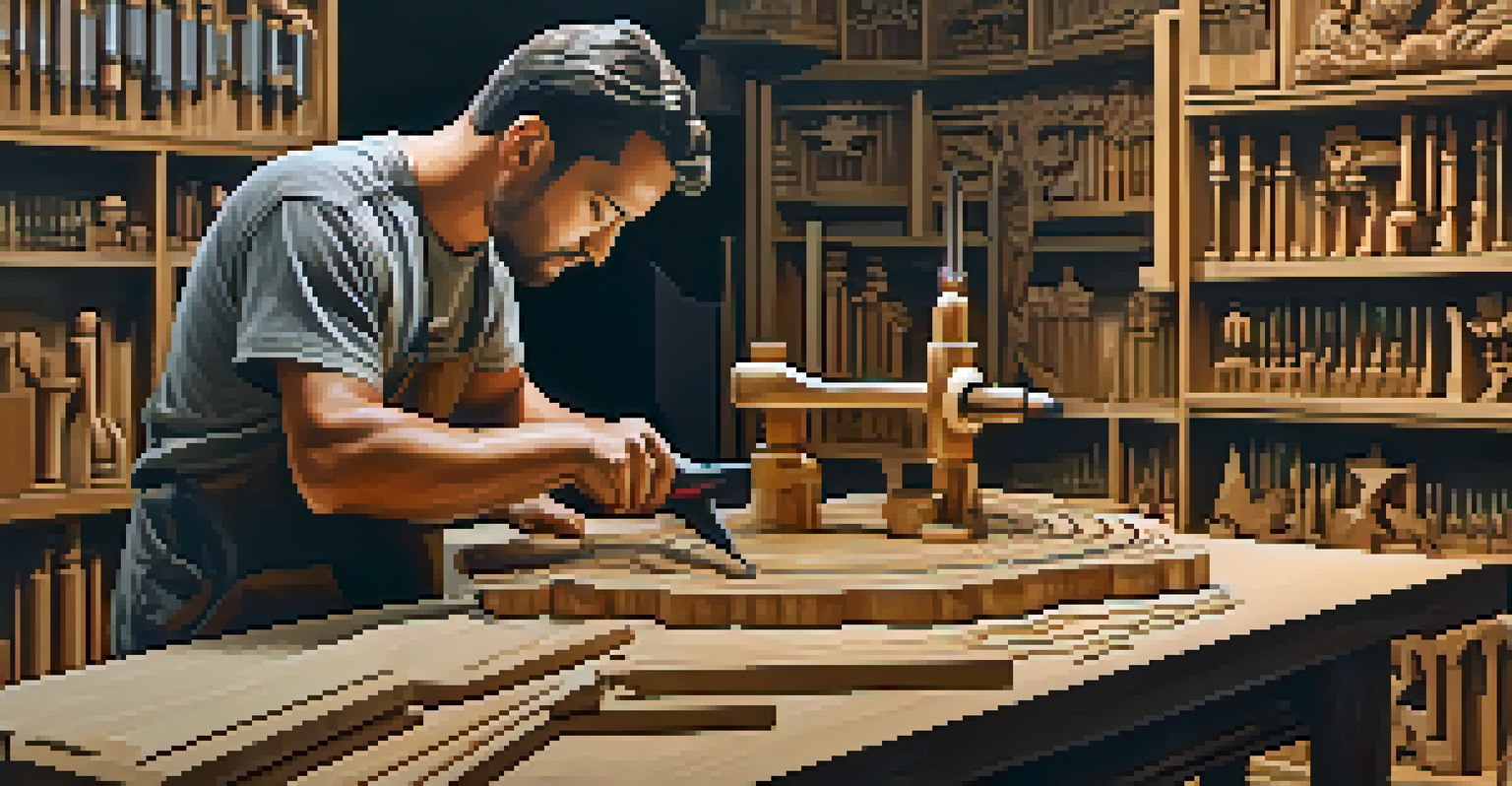The Impact of Technology on Carving in Religious Art

Introduction to Technology in Religious Carving
Religious carving has a rich history, often reflecting the beliefs and values of a culture. With the advent of technology, this art form has seen significant transformations. From traditional hand tools to modern machinery, technology reshapes how artisans create intricate designs and representations.
Art is not freedom from discipline, but disciplined freedom.
The introduction of tools like CNC machines allows for precision that was previously unattainable. This innovation enables artists to replicate complex patterns and forms with ease, enhancing the accessibility of religious symbols. As a result, the fusion of technology and craftsmanship opens new avenues for creativity in religious art.
Yet, while technology can improve efficiency and precision, it may also raise questions about authenticity and the human touch in art. As we delve deeper, we will explore both the benefits and challenges that technology brings to this ancient craft.
Traditional Techniques vs. Modern Tools
For centuries, religious carvers relied on traditional techniques passed down through generations. Tools like chisels and mallets allowed artisans to infuse their work with personal style and spirituality. Each piece was a labor of love, reflecting the unique skills and dedication of the artist.

In contrast, modern technology introduces tools such as laser cutters and 3D printers, which can produce intricate designs quickly and with remarkable detail. These advancements can enhance the visual impact of religious carvings, making them more appealing to contemporary audiences. However, this shift can also lead to a loss of the deep, tactile connection that traditional methods fostered.
Technology Transforms Religious Art
The integration of modern tools like CNC machines and 3D printing enhances the precision and accessibility of religious carvings.
The balance between preserving traditional techniques and embracing modern tools is a delicate dance. Finding harmony between these approaches can enrich the artistic landscape, ensuring that religious carvings remain both meaningful and relevant.
The Role of 3D Printing in Religious Art
3D printing has revolutionized many fields, and religious art is no exception. This cutting-edge technology allows for the creation of intricate designs that were once labor-intensive and time-consuming. By using digital models, artists can produce replicate pieces that capture the essence of traditional carvings with unprecedented precision.
Technology is best when it brings people together.
Moreover, 3D printing democratizes access to religious art, making it possible for smaller communities to create their own symbols and artifacts. This accessibility can help preserve local traditions and foster a deeper connection to cultural heritage. As communities embrace 3D technology, they can innovate while staying true to their spiritual roots.
However, it’s essential to consider the implications of this shift. As digital reproduction becomes commonplace, questions about originality and the significance of craftsmanship arise, prompting discussions about what it means to create art in a digital age.
Preservation of Cultural Heritage through Technology
Technology plays a crucial role in preserving cultural heritage, especially in the realm of religious art. Digital archiving techniques allow for the documentation of traditional carvings that might be at risk of fading or being lost over time. Through high-resolution imaging and scanning, these works can be preserved for future generations.
Furthermore, virtual reality (VR) and augmented reality (AR) technologies offer immersive experiences that allow individuals to engage with religious carvings in new ways. These technologies can provide insights into the cultural significance of each piece, connecting viewers with the stories behind them. As a result, technology not only preserves but also enhances our understanding of this rich art form.
Balancing Tradition and Innovation
Artisans face the challenge of preserving traditional techniques while adapting to technological advancements in their craft.
While these advancements are promising, they also require careful consideration of ethical implications. Balancing preservation with respect for cultural origins is vital in ensuring that technology serves to enhance rather than exploit.
Challenges Faced by Traditional Artists
The integration of technology into religious carving presents challenges for traditional artists. Many artisans fear that the rise of mechanized tools will render their skills obsolete. This concern is particularly poignant in communities where craftsmanship and heritage are deeply intertwined.
As modern methods gain popularity, traditional artists may struggle to find their place in a rapidly changing landscape. The challenge lies in maintaining relevance while preserving the authenticity of their art. For many, the heart of religious carving is not just in the final product but in the meticulous process and the spiritual connection it fosters.
Despite these challenges, many traditional artists are finding ways to adapt. By incorporating technology while honoring their roots, they can create unique hybrids that resonate with both contemporary audiences and traditional values.
The Future of Religious Carving in a Tech-Driven World
As technology continues to evolve, the future of religious carving holds exciting possibilities. Artists are increasingly blending traditional craftsmanship with cutting-edge techniques to create innovative works that reflect both heritage and modernity. This fusion can result in pieces that resonate deeply with diverse audiences.
Moreover, the global reach of technology allows for cross-cultural exchanges that enrich religious art. Artists can collaborate across borders, sharing techniques and inspirations that challenge conventional boundaries. This interconnectedness can foster a vibrant dialogue about faith, culture, and expression.
Cultural Heritage Preservation
Digital archiving and immersive technologies help preserve and enhance the understanding of religious art for future generations.
Ultimately, the future of religious carving will be shaped by how artists choose to navigate the relationship between tradition and innovation. By embracing both, they can create works that honor the past while inspiring future generations.
Conclusion: Embracing Change in Religious Art
In conclusion, the impact of technology on religious carving is multifaceted, presenting both opportunities and challenges. As artisans explore new tools and techniques, they must also grapple with the significance of their craft in a digital age. The essence of religious art lies in its ability to connect us with our beliefs and communities.
By embracing change while honoring tradition, artists can create meaningful works that reflect the complexities of modern spirituality. Whether through traditional methods or innovative technology, the goal remains the same: to inspire, uplift, and engage.

As we move forward, it's essential to recognize the value of both approaches. The dialogue between technology and tradition will continue to shape the landscape of religious carving, ensuring that this ancient art form remains vibrant and relevant.